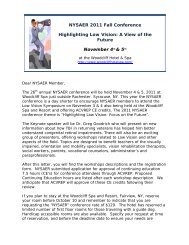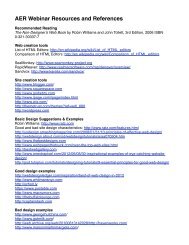Association for Education and Rehabilitation of the ... - AER Online
Association for Education and Rehabilitation of the ... - AER Online
Association for Education and Rehabilitation of the ... - AER Online
Create successful ePaper yourself
Turn your PDF publications into a flip-book with our unique Google optimized e-Paper software.
Family Perspectives on Cochlear Implants<br />
ghue, 2001; Zaidman-Zait & Most, 2005). Zaidman-<br />
Zait (2007) found that families indicated <strong>the</strong>y<br />
expected more rapid progress in <strong>the</strong> first few months<br />
following implantation. Such appears to be <strong>the</strong> case<br />
in <strong>the</strong> current investigation as well; 67 percent <strong>of</strong><br />
parents (n 5 40) who responded to <strong>the</strong> current<br />
survey agreed or strongly agreed with <strong>the</strong> statement<br />
that ‘‘progress during <strong>the</strong> first few months’’ following<br />
implantation ‘‘seemed very slow.’’<br />
Services<br />
Increased social interaction involving meaningful<br />
sounds <strong>and</strong> more specific intervention in <strong>the</strong> child’s<br />
home environment are recommended because only<br />
38 percent <strong>of</strong> parents reported <strong>the</strong>ir child postimplant<br />
‘‘participates in family activities more.’’ Simply<br />
receiving a cochlear implant does not guarantee a<br />
child’s increased participation. A child’s participation<br />
should be facilitated by systematically teaching<br />
families to provide opportunities <strong>for</strong> meaningful use<br />
<strong>of</strong> auditory perception <strong>and</strong> oral language in natural<br />
routines <strong>and</strong> activities. A child must have opportunities<br />
to hear meaningful speech <strong>and</strong> language within<br />
<strong>the</strong> context <strong>of</strong> communicative interactions.<br />
Children need to be taught how to use auditory<br />
skills in au<strong>the</strong>ntic environments. Examples <strong>of</strong> skills<br />
needing to be taught include differing responses to<br />
familiar speech, environmental sounds, music, <strong>and</strong><br />
unfamiliar speech; use <strong>of</strong> vocalizations/verbalizations<br />
as communication, vocal inflection, <strong>and</strong> intonation;<br />
<strong>and</strong> expansion <strong>of</strong> receptive <strong>and</strong> expressive vocabularies<br />
(Bashinski, Stremel Thomas, & Dur<strong>and</strong>o,<br />
2009). Forty-three percent <strong>of</strong> parents (n 5 26)<br />
expressed ‘‘worry that [<strong>the</strong>ir] child might not be<br />
receiving <strong>the</strong> support services’’ needed; 30 percent<br />
(n 5 18) indicated <strong>the</strong>ir child has only ‘‘received<br />
services from a speech/language pathologist who did<br />
not have specific training regarding how to teach a<br />
child to use a cochlear implant.’’ Responses such as<br />
<strong>the</strong>se, indicating parents’ concerns regarding <strong>the</strong><br />
frequency <strong>and</strong>/or quality <strong>of</strong> services <strong>the</strong>ir child is<br />
receiving, indicate <strong>the</strong> need <strong>for</strong> service providers <strong>and</strong><br />
agencies to become more knowledgeable regarding<br />
proactive strategies <strong>for</strong> meeting <strong>the</strong> needs <strong>of</strong> <strong>the</strong><br />
children with vision loss/blindness, motor disabilities,<br />
<strong>and</strong> cognitive delay who have received a cochlear<br />
implant.<br />
Archbold, Nikolopoulos, & Lloyd-Richmond (2009)<br />
documented noticeable changes in <strong>the</strong> use/nonuse<br />
<strong>of</strong> a cochlear implant, child outcomes, <strong>and</strong> educa-<br />
88 | <strong>AER</strong> Journal: Research <strong>and</strong> Practice in Visual Impairment <strong>and</strong> Blindness<br />
tional placement <strong>for</strong> as long as 7 years after<br />
implantation. Several studies investigating long-term<br />
outcomes with children who are deaf only have found<br />
that children’s communication mode changes significantly<br />
over <strong>the</strong> long-term—even so much as 5 to<br />
7 years postimplant (Archbold et al., 2009; Watson,<br />
Archbold, & Nikolopoulos, 2006). These findings are<br />
in stark contrast to this survey’s finding that 38<br />
percent <strong>of</strong> respondents (n 5 23) indicated <strong>the</strong>ir child<br />
received no services related to learning to use <strong>the</strong><br />
implant only 3 years postsurgery.<br />
Process <strong>of</strong> Implantation<br />
Although 88 percent <strong>of</strong> families in <strong>the</strong> current<br />
study indicated ‘‘it was easy to get a referral from<br />
[<strong>the</strong>] child’s doctor to <strong>the</strong> implant center’’ (n 5 53),<br />
12 percent <strong>of</strong> families experienced some difficulty<br />
securing a referral. It is also important to note that 13<br />
percent <strong>of</strong> respondents (n 5 8) had difficulty finding<br />
an implant center that would implant <strong>the</strong>ir child; this<br />
finding was rein<strong>for</strong>ced by a number <strong>of</strong> families who<br />
communicated in<strong>for</strong>mally with <strong>the</strong> researchers. From<br />
results <strong>of</strong> this survey, it cannot be determined<br />
whe<strong>the</strong>r various implant centers had different criteria<br />
<strong>for</strong> implantation, or if <strong>the</strong>y were simply hesitant to<br />
implant children with multiple disabilities.<br />
Berrettini <strong>and</strong> colleagues (2008) found that almost<br />
all (96 percent) parents/guardians <strong>of</strong> <strong>the</strong> participants<br />
(deaf with additional disabilities, but no mention <strong>of</strong><br />
vision loss) indicated that, given <strong>the</strong> option to implant<br />
<strong>the</strong>ir child again, <strong>the</strong>y would chose to do so. The<br />
results <strong>of</strong> <strong>the</strong> current family survey showed slightly<br />
lower results, with 85 percent <strong>of</strong> respondents<br />
indicating <strong>the</strong>y would chose to seek an implant <strong>for</strong><br />
<strong>the</strong>ir child again.<br />
Implications <strong>for</strong> Daily Use<br />
Survey findings confirmed through direct communication<br />
with participating families emphasize<br />
that parents need more effective strategies <strong>for</strong><br />
ensuring <strong>the</strong> implants stay in place on <strong>the</strong>ir children<br />
who have motor challenges/cerebral palsy. Thirtyfive<br />
percent <strong>of</strong> respondents (n 5 21) agreed or<br />
strongly agreed with having ‘‘trouble keeping <strong>the</strong><br />
implant on [<strong>the</strong>] child because <strong>of</strong>…motor disabilities.’’<br />
For those children who voluntarily take <strong>the</strong>ir<br />
implants <strong>of</strong>f, as reported by 24 parents (40<br />
percent), more systematic procedures are needed<br />
to help <strong>the</strong>m learn to tolerate, <strong>and</strong> perhaps even<br />
enjoy, wearing <strong>the</strong> device.







